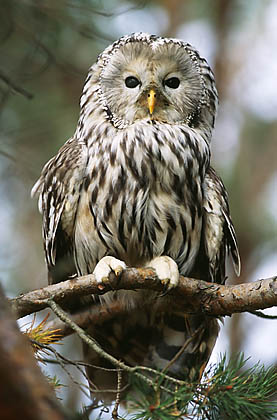Ural owl out hunting
Photo: Arne Ader
Translation: Liis
Ural owl
| Ural owl |
Händkakk
|
Strix uralensis |
Our daylight time is shorter by each day. The more we go towards winter the better are the chances to meet an Ural owl in a suitable lookout tree. It is a large bird with the gliding and soundless flight characteristic for owls. The female is nearly one third heavier than the male birds – but doesn’t quite reach one kilo in weight – and so also larger. Earlier they could only be seen in ancient conifer forests, now they have also settled in deciduous forests in western Estonia; only on the islands they are just stray visitors. They can be seen hunting at the borders of very different types of forests, bogs and marshes.
The Ural owl has a long body and tail and rather pale-coloured plumage. The dark eyes are circled in grey, the beak is yellow and the area under the beak grey. The legs are whitish, the claws black.
Their winter number depends on the supply of their basic food, rodents, and varies from three thousand to five thousand individuals over the years. In the winter of 2005 there was a great number of mice and Ural owls came from Russia to winter here. Such “mouse years” come with intervals of 4 to 6 years, but this is no strict rule, just observations.









